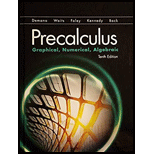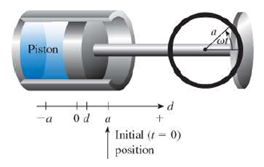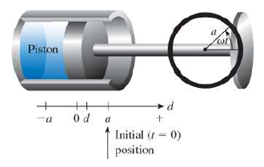
a.
The frequency of the piston.
The frequency of the piston 0.5 cycles/sec.
Given:
Given, the wheel in a piston linkage like the one shown in the figure below has a radius of 18 cm and turns with an angular velocity of p rad/sec. The initial position is the same as shown in the figure:

Calculation:
The equation modelling the motion is of the form
The frequency of the motion is given by:
The frequency of the piston is 0.5 cycles/sec.
Conclusion:
The frequency of the piston is 0.5 cycles/sec.
b.
The equation that models the motion of the piston.
The equation that models the motion of the piston is
Given:
Given, the wheel in a piston linkage like the one shown in the figure below has a radius of 18 cm and turns with an angular velocity of p rad/sec. The initial position is the same as shown in the figure:

Calculation:
In the given model,
Hence,
The equation of the motion of the piston is
Conclusion:
The equation of the motion of the piston is
c.
The number of cycles the piston makes in 1 min.
The number of cycles the piston makes in 1 minute is 30 cycles.
Given:
Given, the wheel in a piston linkage like the one shown in the figure below has a radius of 18 cm and turns with an angular velocity of p rad/sec. The initial position is the same as shown in the figure:

Calculation:
1 minute equals 60 seconds.
The piston makes 0.5 cycles/sec.
Hence, for 60 seconds,
The number of cycles made by the piston in 1 minute is
Conclusion:
The number of cycles the piston makes in 1 minute is 30 cycles.
Chapter 4 Solutions
EBK PRECALCULUS:GRAPHICAL,...-NASTA ED.
- Use a graphing calculator to find where the curves intersect and to find the area between the curves. y=ex, y=-x²-4x a. The left point of intersection is (Type integers or decimals rounded to the nearest thousandth as needed. Type an ordered pair.)arrow_forwardFind the area between the curves. x= -5, x=3, y=2x² +9, y=0 The area between the curves is (Round to the nearest whole number as needed.)arrow_forwardcan you solve these questions with step by step with clear explaination pleasearrow_forward
- Find the area between the following curves. x=-1, x=3, y=x-1, and y=0 The area between the curves is (Simplify your answer.)arrow_forwardFind the area between the curves. x= − 2, x= 3, y=5x, y=x? - 6 6 The area between the curves is (Simplify your answer.) ...arrow_forwardplease question 9arrow_forward
- Use the definite integral to find the area between the x-axis and f(x) over the indicated interval. Check first to see if the graph crosses the x-axis in the given interval. 3. f(x) = 4x; [-5,3]arrow_forwardUse the definite integral to find the area between the x-axis and f(x) over the indicated interval. Check first to see if the graph crosses the x-axis in the given interval. f(x)=3e-4; [3,3]arrow_forwardA small company of science writers found that its rate of profit (in thousands of dollars) after t years of operation is given by P'(t) = (7t + 14) (t² + 4t+7) * (a) Find the total profit in the first four years. (b) Find the profit in the sixth year of operation. (c) What is happening to the annual profit over the long run?arrow_forward
- Calculus III May I have an expert explained how the terms were simplified into 6(3-x)^2? Thank you,arrow_forwardCalculus III May I have an expert explain how the integrand was simplified into the final for form to be integrated with respect to x? Thank you,arrow_forwardCalculus lll May I please have the semicolon statement in the box defined with explanation? Thank you,arrow_forward
 Calculus: Early TranscendentalsCalculusISBN:9781285741550Author:James StewartPublisher:Cengage Learning
Calculus: Early TranscendentalsCalculusISBN:9781285741550Author:James StewartPublisher:Cengage Learning Thomas' Calculus (14th Edition)CalculusISBN:9780134438986Author:Joel R. Hass, Christopher E. Heil, Maurice D. WeirPublisher:PEARSON
Thomas' Calculus (14th Edition)CalculusISBN:9780134438986Author:Joel R. Hass, Christopher E. Heil, Maurice D. WeirPublisher:PEARSON Calculus: Early Transcendentals (3rd Edition)CalculusISBN:9780134763644Author:William L. Briggs, Lyle Cochran, Bernard Gillett, Eric SchulzPublisher:PEARSON
Calculus: Early Transcendentals (3rd Edition)CalculusISBN:9780134763644Author:William L. Briggs, Lyle Cochran, Bernard Gillett, Eric SchulzPublisher:PEARSON Calculus: Early TranscendentalsCalculusISBN:9781319050740Author:Jon Rogawski, Colin Adams, Robert FranzosaPublisher:W. H. Freeman
Calculus: Early TranscendentalsCalculusISBN:9781319050740Author:Jon Rogawski, Colin Adams, Robert FranzosaPublisher:W. H. Freeman
 Calculus: Early Transcendental FunctionsCalculusISBN:9781337552516Author:Ron Larson, Bruce H. EdwardsPublisher:Cengage Learning
Calculus: Early Transcendental FunctionsCalculusISBN:9781337552516Author:Ron Larson, Bruce H. EdwardsPublisher:Cengage Learning





